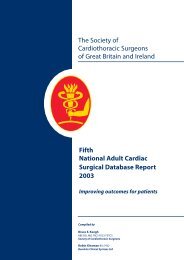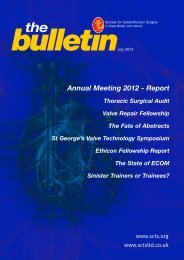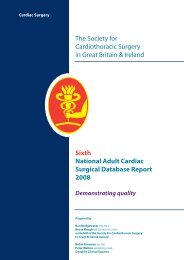A guide to commissioning cardiac surgical services - NHS ...
A guide to commissioning cardiac surgical services - NHS ...
A guide to commissioning cardiac surgical services - NHS ...
Create successful ePaper yourself
Turn your PDF publications into a flip-book with our unique Google optimized e-Paper software.
A <strong>guide</strong> <strong>to</strong> <strong>commissioning</strong> <strong>cardiac</strong> <strong>surgical</strong> <strong>services</strong><br />
“<br />
University Hospitals Birmingham is still in the process of fully rolling out<br />
the project. However, we have already seen benefits <strong>to</strong> patients with the<br />
expansion of pre-assessment and pre-screening clinics as well as the<br />
development of anaesthetic-led pre-assessment clinics. We look forward<br />
<strong>to</strong> receiving comments from patients about their pre-operative pathway<br />
so that we can evaluate our success so far and identify any further<br />
improvements <strong>to</strong> be made. We also welcomed the opportunity <strong>to</strong> work<br />
with a local referring cardiology centre <strong>to</strong> identify bottlenecks in the<br />
patient pathway and are currently working <strong>to</strong> resolve these.<br />
I feel the project group has benefitted from networking with other<br />
centres who have identified similar issues and we have learnt from<br />
their experiences how <strong>to</strong> overcome these <strong>to</strong> ensure the overall<br />
success of the project.<br />
”<br />
Emma Billingham, Group Manager<br />
Top tips<br />
• Mapping the existing pathway is<br />
essential in understanding timelines<br />
and delays in the system.<br />
• Strong clinical leadership (cardiology<br />
and <strong>cardiac</strong> surgeons).<br />
• Obtain baseline data <strong>to</strong> identify if a<br />
problem exists and build in robust<br />
data collection mechanisms <strong>to</strong><br />
support improvement work.<br />
• Understanding the funding<br />
implications and identifying who is<br />
going <strong>to</strong> fund what (things like<br />
annual service costs for a piece of kit<br />
etc) as early as possible in the project<br />
<strong>to</strong> avoid issues later on.<br />
• Develop a communication plan <strong>to</strong><br />
facilitate the dissemination of project<br />
information <strong>to</strong> all admin and<br />
clerical/managerial and clinical staff<br />
involved in the pathway as this helps<br />
<strong>to</strong> foster support and buy in <strong>to</strong> the<br />
improvement work making it<br />
everybody’s business.<br />
• Bringing <strong>to</strong>gether key stakeholders<br />
from the referring provider unit and<br />
tertiary centre <strong>to</strong>gether <strong>to</strong> identify<br />
issues and problems and develop joint<br />
solutions.<br />
• Understanding the patient/carer<br />
experience is fundamental <strong>to</strong> the<br />
success of any quality improvement<br />
work.<br />
Contact details:<br />
Emma Billingham<br />
Group Manager<br />
University Hospitals Birmingham<br />
<strong>NHS</strong> Foundation Trust<br />
emma.billingham@uhb.nhs.uk<br />
www.improvement.nhs.uk/heart<br />
17
















